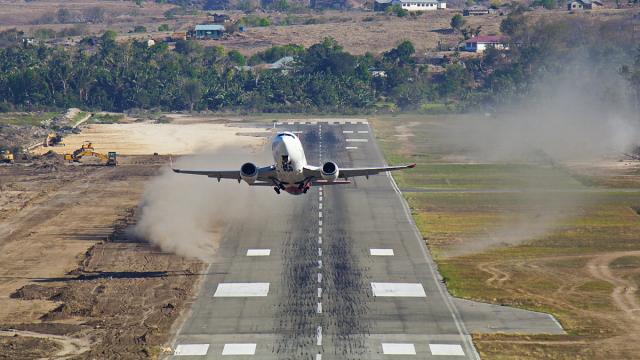Last month, as a record-breaking heat wave swept through the southwest United States, dozens of flights were cancelled when the blisteringly hot conditions made it hard for jets to take off. New research suggests this wasn’t a one-off event, and that global warming could make it increasingly difficult for planes around the world to take off in the coming decades.
A Boeing 737 takes off from Mau Hau Airport. (Image: Riyad Filza/Wikimedia)
The problem has to do with basic aerodynamics. As air gets warmer, its density declines, and in this thinner air, wings are less able to generate lift. When it gets super hot — like around 49C — a pilot waiting for takeoff has to start taking certain factors into consideration, such as the type of aircraft, the length of the runway, the weight of the plane, and so on. In some cases, a plane filled with passengers and their luggage will be unable to take off safely when the temperature is soaring.
New research published in Climatic Change shows that, as temperatures around the world increase, and as heat waves occur with more frequency, airlines will be confronted with this problem on the regular. According to the study, 10 to 30 per cent of fully-loaded planes may be unable to fly during the hottest parts of the day in the future, forcing airlines to remove some fuel, cargo or passengers. Alternately, airlines could wait for cooler hours to fly, such as during the night. Regardless, this will likely pose a major headache for both airlines and passengers.
“Our results suggest that weight restriction may impose a non-trivial cost on airline and impact aviation operations around the world,” said lead author Ethan Coffel, a Columbia University PhD. student, in a statement.
As noted in the study, average global temperatures have risen by nearly 1C since 1980, and they’re expected to go up another 3C by 2100 if emissions continue to grow unchecked. Climate change is also altering weather patterns, making heat waves more prevalent. Coffel and his colleagues project annual maximum daily temperatures at airports worldwide to rise 4 to 8C by 2080. And it’s these heat waves, the researchers say, that will likely produce the most problems.
To understand the difficulties of future flights in a warming world, Coffel’s team used pre-existing climate models, and observations from the NOAA-NCEI Global Historical Climatology Network (GHCN). The researchers considered performance models across a wide range of jets, including the common Boeing 737-800, and over a dozen of the busiest airports around the world, including those in the United States, Europe, the Middle East, China and South Asia.
The airport most challenged by future heat waves will be those featuring short runways, high altitudes, and, unsurprisingly, a propensity for heat waves. All things being equal (that is, we do nothing to curb greenhouse gas emissions), the study projects some planes will have to reduce fuel capacities and payload weights by as much as four per cent on the hottest days. That could amount to a reduction of 12 to 13 fewer passengers on an average 160-seat craft. In the most extreme cases, a big plane on a short runway would have to reduce its passengers by half.
To address these problems, the researchers suggest designing new engines or body designs, and expanding runway lengths. But these solutions are expensive and, for some airports, simply impossible. We also need to start fixing this thing that is climate change.
